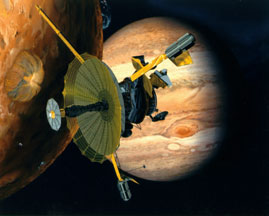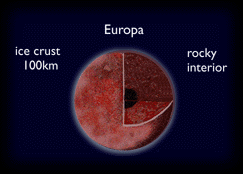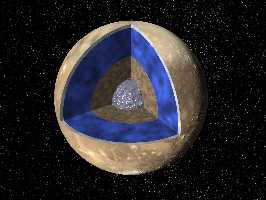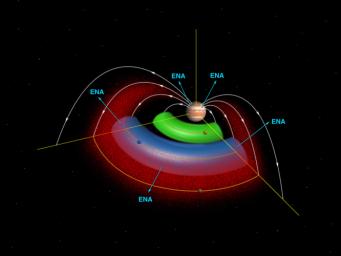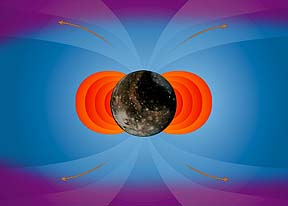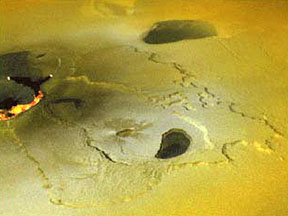Click on image for full size
Image courtesy NASA/JPL.
Related links:
Galileo Reaches the End of its Road
News story originally written on September 19, 2003
The Galileo spacecraft has finally reached the end of its road. Galileo has been orbiting Jupiter since 1995. On September 21, 2003, Galileo will dive into Jupiter's atmosphere and burn up. This crash into Jupiter is not an accident; mission planners have aimed the robotic spacecraft at Jupiter!
Galileo has lasted much longer than its original mission plan intended. But now Galileo is running low on fuel and its instruments are failing after years of exposure to radiation. The Galileo mission team could shut Galileo down and letting it drift in orbit around Jupiter. Instead, they have chosen to aim the craft on a collision course with Jupiter. Why? Europa, one of Jupiter's moons, is one of the most likely places in the Solar System to find life. If Galileo is left to drift, there is a chance it might someday crash into Europa. There may be living microbes (or their spores) lurking somewhere inside the Galileo spacecraft. A crash into Europa could infect the moon with Earthly microbes.
Galileo has been a very successful mission that has helped us learn a great deal about the largest planet in our Solar System, its many moons and complex rings, and the vast magnetic fields and deadly radiation belts that surround Jupiter. The Galileo mission crew is sad to see Galileo end. However, they are proud of what Galileo has done in its long mission. They made a list of some of Galileo's greatest accomplishments. Here are some of those:
- There may be an ocean under the icy surface of the moon Europa.
- Two other moons, Ganymede and Callisto, may also have layers of salty water beneath their surfaces.
- Europa, Io, and Ganymede all have metallic cores. Callisto does not; it is a big ball of ice.
- Europa, Ganymede, and Callisto all seem to have thin atmospheres.
- Ganymede has a magnetic field.
- Io has many, many volcanoes. It may be a lot like Earth was when Earth was young. Maybe we can learn about Earth's early history by studying Io.
- Jupiter's ring system is formed by dust kicked up by meteoroids that smash into the planet's four small inner moons. The outermost ring is actually two rings, one inside of the other.


